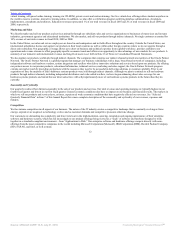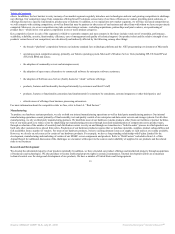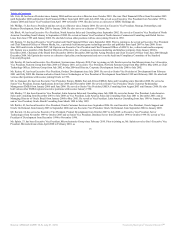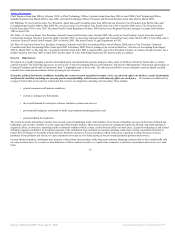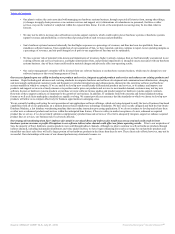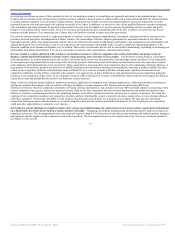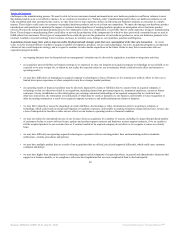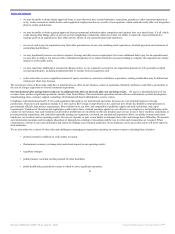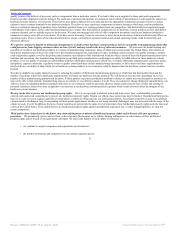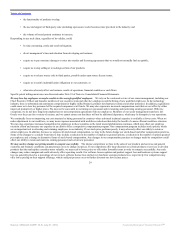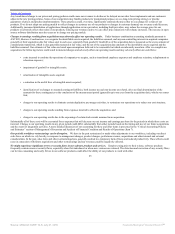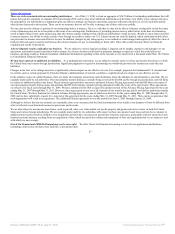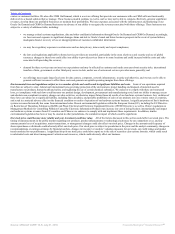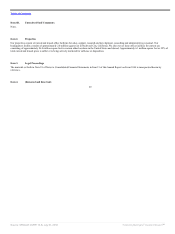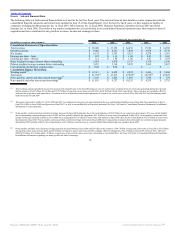Oracle 2009 Annual Report Download - page 26
Download and view the complete annual report
Please find page 26 of the 2009 Oracle annual report below. You can navigate through the pages in the report by either clicking on the pages listed below, or by using the keyword search tool below to find specific information within the annual report.
Table of Contents
• longer payment cycles and difficulties in collecting accounts receivable;
• overlapping tax regimes;
• our ability to repatriate funds held by our foreign subsidiaries to the United States at favorable tax rates;
• difficulties in transferring funds from or converting currencies in certain countries; and
• reduced protection for intellectual property rights in some countries.
As a result of our entry into a new hardware systems business, the volume and complexity of laws and regulations that we are subject to have increased.
As the majority shareholder of Oracle Financial Services Software Limited, a publicly traded Indian software company focused on the banking industry, we are
faced with several additional risks, including being subject to local securities regulations and being unable to exert full control or obtain financial and other
information on a timely basis.
We may experience foreign currency gains and losses. We conduct a significant number of transactions in currencies other than the U.S. Dollar. Changes in
the value of major foreign currencies, particularly the Euro, Japanese Yen and British Pound relative to the U.S. Dollar can significantly affect revenues and our
operating results. Generally, our revenues and operating results are adversely affected when the dollar strengthens relative to other currencies and are positively
affected when the dollar weakens. For example, our revenues and operating results in fiscal 2009 were unfavorably affected by the strengthening of the
U.S. Dollar relative to most other major foreign currencies.
In addition, we incur foreign currency transaction gains and losses, primarily related to sublicense fees and other intercompany agreements among us and our
subsidiaries and distributors that we expect to cash settle in the near term, that are charged against earnings in the period incurred. We have a program that
primarily utilizes foreign currency forward contracts to offset the risks associated with these foreign currency exposures, which we may suspend from time to
time. This program was active for the majority of fiscal 2010 and was suspended during our fourth quarter of fiscal 2010. When the program is active, we enter
into foreign currency forward contracts so that increases or decreases in our foreign currency exposures are offset by gains or losses on the foreign currency
forward contracts in order to mitigate the risks and volatility associated with our foreign currency transaction gains or losses. As a large portion of our
consolidated operations are international, we could experience additional foreign currency volatility in the future, the amounts and timing of which are variable.
We will continue to experience foreign currency gains and losses in certain instances when we suspend our foreign currency forward contract program or where
it is not possible or cost effective to hedge our foreign currency exposures. For example, if overall foreign currency exchange rates weakened subsequent to
May 31, 2010, we believe we would recognize foreign currency losses related to cross-currency exposures that our foreign currency forward contracts program,
when active, may be able to mitigate. Our ultimate realized loss or gain with respect to currency fluctuations will generally depend on the size and type of
cross-currency exposures that we enter into, the currency exchange rates associated with these exposures and changes in those rates, whether we have entered
into foreign currency forward contracts to offset these exposures and other factors. All of these factors could materially impact our results of operations, financial
position and cash flows, the timing of which is variable and generally outside of our control. For example, during fiscal 2010, we incurred foreign currency losses
associated with our Venezuelan subsidiary due to it being designated as operating in a highly inflationary economy and due to the subsequent devaluation of the
Venezuelan Bolivar relative to the U.S. Dollar.
The future operating results of our hardware systems business will depend on our ability to manage our component inventory to meet the demands of our
hardware systems customers and to avoid component inventory write-downs. Sun’s hardware systems business has historically depended upon suppliers to
design, develop, manufacture and deliver on a timely basis the necessary components for its hardware products. While many of the components historically
purchased have been standard, some components (standard or otherwise) have required long lead times to manufacture and deliver. Furthermore, there are some
components that can only be purchased from a single vendor due to price, quality, technology or other business constraints. At times we may be unable to
purchase these items from the respective single vendors on acceptable terms or may experience significant delays or
22
Source: ORACLE CORP, 10-K, July 01, 2010 Powered by Morningstar® Document Research℠


